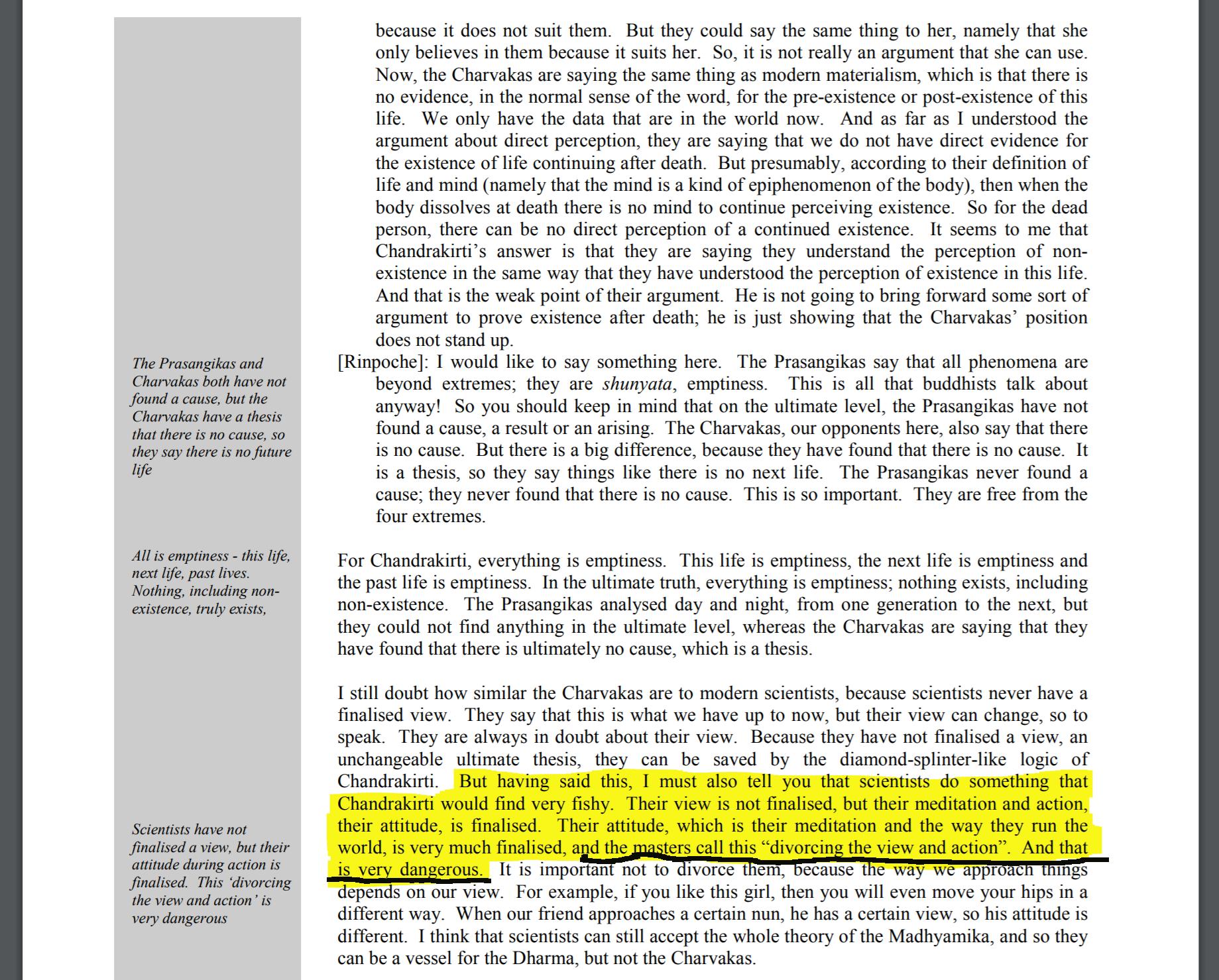What is meant by "divorcing the view and the action" and why is it considered so dangerous?
3
votes
2
answers
121
views
In Chandrakirti’s Madhyamakavatara, there is a debate with the Charvakas (ancient materialists) about the existence or non-existence of past and future lives. In the commentary, Rinpoche compares and contrasts the Charvakas tenets with modern day scientists who would deny the conventional existence of past or future lives.
Rinpoche accuses modern scientists with the phrase "divorcing the view and the action" and advises that this is a saying among masters to describe something considered very dangerous:
 As Rinpoche implies that this phrase is commonly used by masters to describe something very dangerous I am wondering if there are other examples of masters using this phrase and why it is considered so dangerous. Can anyone find Sutra/Treatise/Commentary/Anecdote of other masters using this phrase?
I'm also wondering if it is appropriate to describe modern Secular Buddhists who also deny the conventional existence of past or future lives as holding the same view as modern scientists and subject to this same phrase? If so, why is this so dangerous and what is meant by "divorcing the view and the action?"
What is the translation of this phrase in Pali, Sanskrit, or Tibetan to the extent that there are examples of masters using this phrase in a similar way in any of these languages?
As Rinpoche implies that this phrase is commonly used by masters to describe something very dangerous I am wondering if there are other examples of masters using this phrase and why it is considered so dangerous. Can anyone find Sutra/Treatise/Commentary/Anecdote of other masters using this phrase?
I'm also wondering if it is appropriate to describe modern Secular Buddhists who also deny the conventional existence of past or future lives as holding the same view as modern scientists and subject to this same phrase? If so, why is this so dangerous and what is meant by "divorcing the view and the action?"
What is the translation of this phrase in Pali, Sanskrit, or Tibetan to the extent that there are examples of masters using this phrase in a similar way in any of these languages?
 As Rinpoche implies that this phrase is commonly used by masters to describe something very dangerous I am wondering if there are other examples of masters using this phrase and why it is considered so dangerous. Can anyone find Sutra/Treatise/Commentary/Anecdote of other masters using this phrase?
I'm also wondering if it is appropriate to describe modern Secular Buddhists who also deny the conventional existence of past or future lives as holding the same view as modern scientists and subject to this same phrase? If so, why is this so dangerous and what is meant by "divorcing the view and the action?"
What is the translation of this phrase in Pali, Sanskrit, or Tibetan to the extent that there are examples of masters using this phrase in a similar way in any of these languages?
As Rinpoche implies that this phrase is commonly used by masters to describe something very dangerous I am wondering if there are other examples of masters using this phrase and why it is considered so dangerous. Can anyone find Sutra/Treatise/Commentary/Anecdote of other masters using this phrase?
I'm also wondering if it is appropriate to describe modern Secular Buddhists who also deny the conventional existence of past or future lives as holding the same view as modern scientists and subject to this same phrase? If so, why is this so dangerous and what is meant by "divorcing the view and the action?"
What is the translation of this phrase in Pali, Sanskrit, or Tibetan to the extent that there are examples of masters using this phrase in a similar way in any of these languages?
Asked by user13375
May 2, 2021, 02:45 PM
Last activity: Apr 25, 2024, 01:19 AM
Last activity: Apr 25, 2024, 01:19 AM